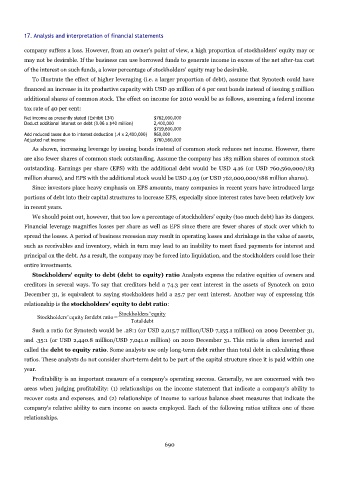Page 689 - Accounting Principles (A Business Perspective)
P. 689
17. Analysis and interpretation of financial statements
company suffers a loss. However, from an owner's point of view, a high proportion of stockholders' equity may or
may not be desirable. If the business can use borrowed funds to generate income in excess of the net after-tax cost
of the interest on such funds, a lower percentage of stockholders' equity may be desirable.
To illustrate the effect of higher leveraging (i.e. a larger proportion of debt), assume that Synotech could have
financed an increase in its productive capacity with USD 40 million of 6 per cent bonds instead of issuing 5 million
additional shares of common stock. The effect on income for 2010 would be as follows, assuming a federal income
tax rate of 40 per cent:
Net income as presently stated (Exhibit 134) $762,000,000
Deduct additional interest on debt (0.06 x $40 million) 2,400,000
$759,600,000
Add reduced taxes due to interest deduction (.4 x 2,400,000) 960,000
Adjusted net income $760,560,000
As shown, increasing leverage by issuing bonds instead of common stock reduces net income. However, there
are also fewer shares of common stock outstanding. Assume the company has 183 million shares of common stock
outstanding. Earnings per share (EPS) with the additional debt would be USD 4.16 (or USD 760,560,000/183
million shares), and EPS with the additional stock would be USD 4.05 (or USD 762,000,000/188 million shares).
Since investors place heavy emphasis on EPS amounts, many companies in recent years have introduced large
portions of debt into their capital structures to increase EPS, especially since interest rates have been relatively low
in recent years.
We should point out, however, that too low a percentage of stockholders' equity (too much debt) has its dangers.
Financial leverage magnifies losses per share as well as EPS since there are fewer shares of stock over which to
spread the losses. A period of business recession may result in operating losses and shrinkage in the value of assets,
such as receivables and inventory, which in turn may lead to an inability to meet fixed payments for interest and
principal on the debt. As a result, the company may be forced into liquidation, and the stockholders could lose their
entire investments.
Stockholders' equity to debt (debt to equity) ratio Analysts express the relative equities of owners and
creditors in several ways. To say that creditors held a 74.3 per cent interest in the assets of Synotech on 2010
December 31, is equivalent to saying stockholders held a 25.7 per cent interest. Another way of expressing this
relationship is the stockholders' equity to debt ratio:
Stockholders 'equity
Stockholders'equity fordebt ratio=
Totaldebt
Such a ratio for Synotech would be .28:1 (or USD 2,015.7 million/USD 7,155.1 million) on 2009 December 31,
and .35:1 (or USD 2,440.8 million/USD 7,041.0 million) on 2010 December 31. This ratio is often inverted and
called the debt to equity ratio. Some analysts use only long-term debt rather than total debt in calculating these
ratios. These analysts do not consider short-term debt to be part of the capital structure since it is paid within one
year.
Profitability is an important measure of a company's operating success. Generally, we are concerned with two
areas when judging profitability: (1) relationships on the income statement that indicate a company's ability to
recover costs and expenses, and (2) relationships of income to various balance sheet measures that indicate the
company's relative ability to earn income on assets employed. Each of the following ratios utilizes one of these
relationships.
690

